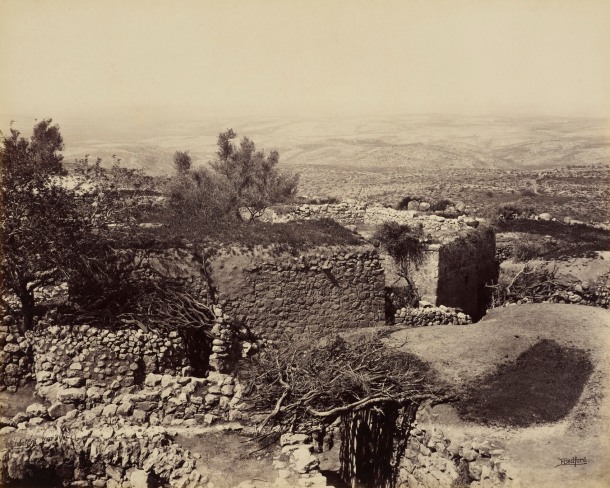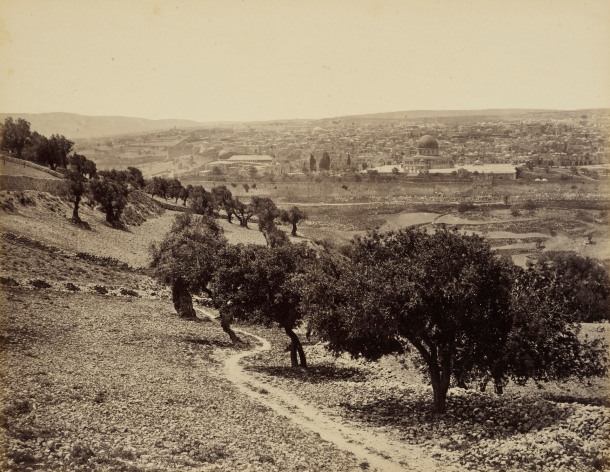A new photographic exhibition in London follows the journey taken by England’s Prince of Wales (later King Edward VII) in 1862, as he undertook a four month tour around the Middle East.
And as usual, no sign of mosques or active Palestinian presence as the decades old argument from the Palestinian side to keep up the saga to fight and occupy, for the sake of jihad and foreign aid.
In the exhibition we find more photographs from Jerusalem in 1862, when the so called “palestinians” allegedly were already 1 million in population on land they profess to have “lost to Jewish occupation” a few decades later. The only problem with this argument is that, as with all photographs up to the second decade of 1900’s, there are rarely any Muslims or mosques to be found on any photographs. The only mosque – and a confiscated synagogue converted after Muslim invasion is the Temple Mount’s Dome of the Rock – and it stands empty of Muslims in ALL pictures through the 1800’s and early 1900’s, demonstrating the falsity in the Palestinian argument. There are more evidence and remains of the massacres Muslims caused on Christians, than any living signs of Muslims themselves. In comparison, other towns with a living Muslim population documented in photographs during the mid and late 1800’s always feature a lot of mosques.
.
.
Cairo to Constantinople: Early Photographs of the Middle East
The Queen’s Gallery, Buckingham Palace
Friday, 7 November 2014 to Sunday, 22 February 2015
This exhibition follows the journey taken by the Prince of Wales (later King Edward VII) in 1862, as he undertook a four month tour around the Middle East.
Seen through the photographs of Francis Bedford (1815-94), the first photographer to travel on a royal tour, it explores the cultural and political significance Victorian Britain attached to the region, which was then as complex and contested as it remains today.
The tour took the Prince to Egypt, Palestine and the Holy Land, Syria, Lebanon, Turkey and Greece where he met rulers, politicians and other notable figures, and travelled in a manner not associated with royalty – by horse and camping out in tents.
On the royal party’s return to England, Francis Bedford’s work was displayed in what was described as ‘the most important photographic exhibition that has hitherto been placed before the public’.
Cairo to Constantinople: Early Photographs of the Middle East is presented alongside Gold at The Queen’s Gallery, Buckingham Palace.
The Mount of Olives and Garden of Gethsemane [Jerusalem]
Creator: Francis Bedford (1815-94) (photographer)
Creation Date: 2 Apr 1862
Materials: Albumen print, mounted on card
Dimensions: 23.4 x 28.5 cm
Acquirer: King Edward VII, King of the United Kingdom (1841-1910), when Albert Edward, Prince of Wales (1841-63)
Provenance: Acquired by the Prince of Wales (later King Edward VII), 1862
Description:
The Mount of Olives rises to the east of Jerusalem. The walled enclosure to the right contains the site identified as the Garden of Gethsemane. After the Last Supper, Jesus went to the garden where he prayed, accompanied by St Peter, St John and St James the Greater. Jesus was subsequently betrayed by Judas in the garden and arrested.
The photograph is signed, captioned and dated (incorrectly as 2 March 1862) in the negative, ‘F Bedford Jerusalem’. The number in the Day & Son series is 63.
Hasbeiya – scene of the massacre [Hasbaya, Lebanon]
Creator: Francis Bedford (1815-94) (photographer)
Creation Date: 26 Apr 1862
Dimensions: 23.2 x 29.0 cm
Acquirer: King Edward VII, King of the United Kingdom (1841-1910), when Albert Edward, Prince of Wales (1841-63)
Provenance: Acquired by the Prince of Wales (later King Edward VII), 1862
Description:
On their route towards Damascus, the royal party stopped at some of the towns and villages close to the Lebanon-Syria border, which had seen fighting during the 1860 conflict. The first town they reached was Hasbaya. The Prince was told that between 800 and 1000 Christians were killed here by the Druze [Muslim Shia minority group].
The photograph is signed, captioned and dated in the negative, ‘F Bedford Hasbeiya’. The number in the Day & Son series is 90.
Garden of Gethsemane [Jerusalem]
Creator: Francis Bedford (1815-94) (photographer)
Creation Date: 2 Apr 1862
Materials: Albumen print, mounted on card
Dimensions: 21.1 x 29.1 cm
Acquirer: King Edward VII, King of the United Kingdom (1841-1910), when Albert Edward, Prince of Wales (1841-63)
Provenance: Acquired by the Prince of Wales (later King Edward VII), 1862
Description:
The Garden of Gethsemane has always been identified as an olive grove. Here the carefully tended, centuries-old olive trees are easily identified.
The photograph is signed, captioned and dated (incorrectly as 2 March 1862) in the negative, ‘F Bedford Gethsemane’. The number in the Day & Son series is 68.
Rasheiya [Rashaya, Lebanon]
Creator: Francis Bedford (1815-94) (photographer)
Creation Date: 27 Apr 1862
Dimensions: 23.6 x 29.0 cm
Acquirer: King Edward VII, King of the United Kingdom (1841-1910), when Albert Edward, Prince of Wales (1841-63)
Provenance:
Acquired by the Prince of Wales (later King Edward VII), 1862
Description:
Rashaya, a mostly Druze-inhabited town [Shia Muslim sect], was the scene of conflict in June 1860. The Prince wrote: ‘In this town, 400 to 500 Christians were massacred and we saw still the remains of the burnt houses.’ In July, the conflict spread from this area into Damascus.
The photograph is signed, captioned and dated in the negative, ‘F Bedford Rasheiya’. The number in the Day & Son series is 92.
Gateway to the “Metzuda” Citadel, Banias, Golan
Creator: Francis Bedford (1815-94) (photographer)
Creation Date: 23 Apr 1862
Dimensions: 23.6 x 28.0 cm
Acquirer: King Edward VII, King of the United Kingdom (1841-1910), when Albert Edward, Prince of Wales (1841-63)
Provenance: Acquired by the Prince of Wales (later King Edward VII), 1862
Description:
View of dilapidated entrance to Citadel – part of complex of Castle of Banyas. Stream runs through ditch in foreground.
The photograph is signed, captioned and dated in the negative, ‘F Bedford Banias’. The number in the Day & Son series is 87.
Upper Bethoron [Beit Ur al-Foqa and the Valley of Ajalon]
Creator: Francis Bedford (1815-94) (photographer)
Creation Date: 31 Mar 1862
Materials: Albumen print, mounted on card
Dimensions: 23.1 x 29.0 cm
Acquirer: King Edward VII, King of the United Kingdom (1841-1910), when Albert Edward, Prince of Wales (1841-63)
Provenance: Acquired by the Prince of Wales (later King Edward VII), 1862
Description:
The Royal Yacht reached Jaffa (modern-day Tel Aviv) on 29 March. The following day the royal party set out on horses in the direction of Jerusalem. En route they visited Beit Ur al-Foqa from where they could view the Valley of Ajalon, the site of a famous biblical battle, fought by Joshua, the leader of the Israelites, against the Amorite kings.
The photograph is signed, captioned and dated in the negative, ‘F Bedford Bethoron’. The number in the Day & Son series is 50.
Jerusalem, From Mount of Olives
Creator: Francis Bedford (1815-94) (photographer)
Creation Date: Mar-Apr 1862
Materials: Albumen print, mounted on card
Dimensions: 22.7 x 29.1 cm
Acquirer: King Edward VII, King of the United Kingdom (1841-1910), when Albert Edward, Prince of Wales (1841-63)
Provenance: Acquired by the Prince of Wales (later King Edward VII), 1862
Description:
View from slopes and olive groves of the Mount of Olives towards distant rooftops of Jerusalem.
The royal party arrived at Jerusalem in the evening of 31 March. They set up a camp outside the city walls, between the Damascus Gate and the Gate of St. Stephen. Their first evening was spent walking along the walls of the town, taking in the view of the city, under the guidance of the Revd Dr Stanley, one of the gentlemen in the Prince’s party.
The photograph is unsigned, uncaptioned and undated. The number in the Day & Son series is 52.

![Hasbeiya - scene of the massacre [Syria]](https://palestineisraelconflict.files.wordpress.com/2014/11/on-the-way-to-damascus.jpg?w=610&h=491)

![Rasheiya [Syria]](https://palestineisraelconflict.files.wordpress.com/2014/11/rasheiya-rashaya-lebanon.jpg?w=610&h=491)



No comments:
Post a Comment